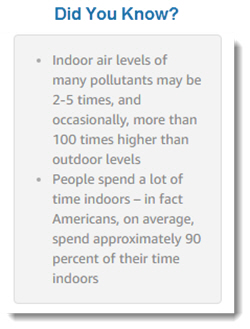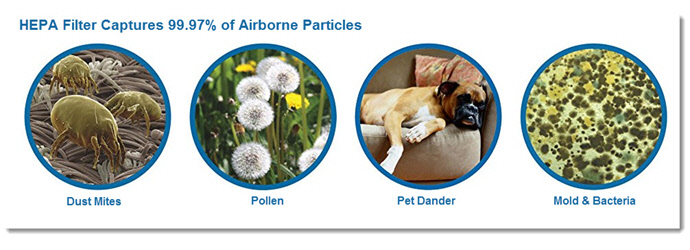Air Purifiers – Our Take
 Air Purifiers have received a great deal of hype in the past few years. They do provide another level of cleaning for your home as the air in your home has to be clean for your home to really be clean.
Air Purifiers have received a great deal of hype in the past few years. They do provide another level of cleaning for your home as the air in your home has to be clean for your home to really be clean.
Also, to have the air cleaned means that the other surfaces in your home will be cleaner as well. Much of the dust that collects on surfaces is transported there via the air in your home.
Here is our advice on how to improve the quality of your indoor air and our take on home air cleaners and purifiers.
First, let’s define two terms that often are used when describing an air purifier.
Air Flow or Air Purifier Capacity
This is the volume of air that can flow through an air purifier. It may be expressed as CFM (cubic feet per minute). It could be expressed as air exchange (with the value being a single number) or it could be air flow per hour.
You may also see a term called CADR (Clean Air Delivery Rate) which is a value that can be used to compare one air purification unit to another. This term is a numerical value assigned to an air purifier based on independent tests performed for the Association of Home Appliance Manufacturers (AHAM). AHAM has been measuring the CADRs of air cleaners and air purifiers since the 1980s so this standard is well established.
Also, according to the online encyclopedia Wikipedia, the CADR definition is an indication of the volume of filtered air delivered by a portable air purifier. It goes on to say that CADR describes how well the cleaner reduces tobacco smoke, pollen, and dust. In other words, the CADR is an attempt to provide a uniform, objective standard by which potential buyers can easily evaluate the effectiveness of an air cleaner and to compare two air purifiers.
Think of the CADR rating as the miles-per-gallon (MPG) rating of a car. If there was not a standard test protocol for MPG then consumers would not be able to easily compare each car they were considering from a fuel use perspective.
The CADR rating provides consumers with an easy comparison number for the air cleaning power of an air purifier just like the MPG number for a car allows us to easily compare fuel efficiency. It is important to note that when CADR is measure it is done when the unit is operating at its highest setting. Operating a unit at a lower setting will reduce the CADR value.
HEPA Filters
HEPA stands for High Efficiency Particulate Air. The term HEPA was commercialized in the 1950s. The original term became a registered trademark. However, today, it is a generic term used for any highly efficient air filter.

Again, from Wikipedia:
HEPA filters, as defined by the United States Department of Energy (DOE) standard, and adopted by most American industries, remove at least 99.97% of airborne particles 0.3 micrometers (µm) in diameter or larger.
With these terms defined let’s first look at three strategies for improving the air quality in your home where an air purifier is the third way of improving the air quality in your home.
The Three Essentials for High-Quality Indoor Air
First – Source Control
Opportunities to improve indoor air quality by eliminating the source is your best first step.
Here is an example.
Reduce or eliminate tobacco smoke, also known as second-hand smoke at its source. Indoor air with high levels of second-hand smoke from tobacco can cause asthma, heart disease, lung cancer, and other major health problems. This is the case not just for the smoker but for anybody who lives with him or her.
First, try to get the get the offender to quit. If quitting is not an option, then make a rule that smoking is only allowed outside. You can enforce this rule for your house guests as well.
If the smoke is not there in the first place, then there is no need to filter it out!
Second – Ventilation
When the weather is nice outside and the air pure and clean just after a rain shower then bring fresh air into the house. Expel the inside air that is not as fresh. Simply, open the windows.
If you have a ventilator in your bathroom or your kitchen, use them regularly. Use a fan or two to increase circulation. If your rooms have windows on multiple sides, then open the windows on multiple sides to create some excellent cross-ventilation.
Third – Air Purifiers
There will still be air pollution in your home even when you address pollution sources and ventilation. No matter how hard you try, you cannot eliminate all the sources of the pollution, and ventilation can only do so much.
However, there is another easy and effective way to reduce the unhealthy particles and minimize the health risks associated with low-quality indoor air.
Purchase a quality air filter!
Air filters will handle pollution that an unaided human could never hope to eliminate. They are an excellent way to ensure that the air you breathe in your home is safe and clean.
Along with controlling the sources of pollution and providing adequate ventilation in your home, the Environmental Protection Agency and the US Consumer Product Safety Commission both endorse the use of air purifiers to clean the air of your home.
Air purifiers are not created equal. The key to achieving proper air filtration is choosing the correct device. The first step, before you comparison shop, is to establish two important aspects for your air purifier.
How to Select an Air Purifier
First, calculate the volume of air you want to clean. For example, you wish to improve the air quality of your office. The air volume calculation for your office is straightforward. You will need to multiply the length and width of the floor with the height of the ceiling.
An office 10 by 16 feet with a ceiling at 10 feet has a volume of air of 1,600 cubic feet.
I recommend choosing an air purifier that can clean the air in your office at a rate of once every 15 minutes or four times per hour. Therefore, we need to consider air purifiers that have a capacity of 4 air exchanges per hour for 1,600 cubic feet. This would be 106 CFM (cubic feet per minute) or 6,400 cubic feet per hour (1,600 cubic feet x 4 = 6,400 cubic feet per hour).
When considering an air purifier consider these two factors:
- Efficiency, or how much harmful material it removes from the air (this relates to filter technology).
- How much air it is capable of drawing through the air purification system.
Consider these two qualities in tandem. A filter that removes a high number of toxins is good. However, it will not be useful if it has a low circulation rate.
Now let’s examine the Germ Guardian AC4825 3-in-1 Air Purifier with a HEPA Filter.
This is not an endorsement of this particular air purifier and is used as an example only.
You may look at the manufacturer’s website page for this air purifier here.
HEPA (yes/no)
First, make sure that the unit you are considering has a HEPA filter. Once you see that it does use HEPA filter technology then you have checked this box.
Now examine air flow rate.
Air Flow, Air Flow Capacity, or Air Exchange Rate
This unit has a manufactures rating of 100 cubic feet per minute. Note that this value is when the unit is operating at full volume. It will be able to filter the volume of air in your office in 16 minutes (4 times per hour). Select a unit which can exchange the air in the area or room of at least 4 times per hour.
Special Features
Beyond using HEPA filter technology and determining the air flow capacity you may also want to examine special features.
The Germ Guardian also uses Ultra Violet light technology to kill bacteria, viruses and mold spores. Moreover, this air purifier uses Titanium Dioxide to break down these pollutants further. There is also a charcoal filter which reduces common odors from pets, smoke, and cooking.
In conclusion, look for an air purifier which has multiple filters or technologies to reduce or eliminate multiple airborne pollutants. Then select a product which has enough air flow to purify the area of concern. You want an air exchange rate of 4 times per hour.
Our Take
We like the idea of having clean air in a clean home. To have clean air will help, in general, to make your home cleaner, smell cleaner, and feel cleaner. Clean air will also enable you to feel better. If allergens and other air-borne contaminants bother you then is particularly true.
Do some good work to eliminate sources of air contamination, increased ventilation and install an air purifier. Then you may want to have A Clean Vision help you with other cleaning tasks. We can help you with vacuuming and cleaning bathrooms and other household cleaning tasks.
Give us a call at 802-295-6065 if you live in the Upper Valley and need extra support for keeping your home clean and tidy.

